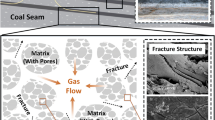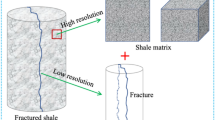Abstract
Pores and fractures are important components of flow channels in coal-measure gas reservoirs. While considerable studies have been conducted on pore structure evolution, very few studies have investigated the fracture distribution and self-similarity characteristics. To reveal the characteristics of fracture distribution in coal and shale reservoirs, computed tomography studies were performed on 15 coal and shale samples from the Shanxi and Taiyuan formations. The results show that the fracture distribution of samples of the same lithology differs significantly, and the fracture distribution heterogeneity of shale samples is much higher than that of coal samples. In shale, the heterogeneity of fracture distribution is mainly caused by pores and fractures smaller than 2 µm in the z-direction, with relatively little contributions from pores and fractures in the x and y directions. However, the heterogeneity of fracture distribution in coal is mainly controlled by pores and fractures larger than 2 µm in all directions, and the difference between the three directions is minor. It was shown that a great number of microscopic pores and fractures contribute to the highest fractions of porosity in different lithological samples. This method is useful for determining the fracture distribution characteristics in shale and coal-measure gas reservoir.
Similar content being viewed by others
References
Chen J, Cheng W, Wang G, Li H M (2022). Effect of dominated coal pores and fractures on water migration after low-pressure water injection based on CT images. Fuel, 307: 121795
Chen X J, Yao G Q, Cai J C, Huang Y T, Yuan X Q (2017). Fractal and multifractal analysis of different hydraulic flow units based on micro-CT images. J Nat Gas Sci Eng, 48: 145–156
Fu X H, Qin Y, Wang G, Rudolph V (2009). Evaluation of coal structure and permeability with the aid of geophysical logging technology. Fuel, 88(11): 2278–2285
Guo L, Ru Z, Xiao-Lian X U, Zhang Y F (2015). CT image reconstruction of coal rock three-dimensional fractures and body fractal dimension under triaxial compression test. Rock Soil Mech, 36(6): 1633–1642 (in Chinese)
Hou P, Liang X, Zhang Y, He J, Gao F, Liu J (2021). 3D multi-scale reconstruction of fractured shale and influence of fracture morphology on shale gas flow. Nat Resour Res, 30(3): 2463–2481
Karimpouli S, Tahmasebi P, Ramandi H L (2020). A review of experimental and numerical modeling of digital coalbed methane: imaging, segmentation, fracture modeling and permeability prediction. Int J Coal Geol, 228: 103552
Li X Y, Chen S B, Wang Y W, Zhang Y K, Wang Y, Wu J F, Zhang J J, Khan J (2022). Influence of pore structure particularity and pore water on the occurrence of deep shale gas: Wufeng–Longmaxi Formation, Luzhou Block, Sichuan Basin. Nat Resour Res, 31(3): 1403–1423
Liu J, Pereira G G, Liu Q B, Regenauer-Lieb K (2016). Computational challenges in the analyses of petrophysics using microtomography and upscaling: a review. Comput Geosci, 89: 107–117
Liu J, Regenauer-Lieb K, Hines C, Zhang S, Bourke P, Fusseis F, Yuan D A (2013). Applications of Microtomography to Multiscale System Dynamics: Visual-isation, Characterisation and High-performance Computation. Berlin: Springer, 653–674
Liu W, Wang G, Han D Y, Xu H, Chu X Y (2021). Accurate characterization of coal pore and fissure structure based on CT 3D reconstruction and NMR. J Nat Gas Sci Eng, 96: 104242
Liu X J, Xiong J, Liang L X (2015). Investigation of pore structure and fractal characteristics of organic-rich Yanchang formation shale in central China by nitrogen adsorption/desorption analysis. J Nat Gas Sci Eng, 22: 62–72
Mou P W, Pan J N, Wang K, Wei J, Yang Y H, Wang X L (2021). Influences of hydraulic fracturing on microfractures of high-rank coal under different in-situ stress conditions. Fuel, 287: 119566
Ni X M, Chen W X, Li Z Y, Gao X (2017a). Reconstruction of different scales of pore-fractures network of coal reservoir and its permeability prediction with Monte Carlo method. Int J Min Sci Technol, 27(4): 693–699
Ni X M, Miao J, Lv R S, Lin X Y (2017b). Quantitative 3D spatial characterization and flow simulation of coal macropores based on μCT technology. Fuel, 200: 199–207
Nie B S, Liu X F, Yang L L, Meng J Q, Li X C (2015). Pore structure characterization of different rank coals using gas adsorption and scanning electron microscopy. Fuel, 158: 908–917
Pan Z J, Wang K, Hou Q L, Niu Q H, Wang H T, Ji Z M (2016). Micro-pores and fractures of coals analyzed by field emission scanning electron microscopy and fractal theory. Fuel, 164: 277–285
Qin Y, Moore T A, Shen J, Yang Z B, Shen Y L, Wang G (2018). Resources and geology of coalbed methane in China: a review. Int Geol Rev, 60(5–6): 777–812
Safari H, Faramarzi-Palangar M, Hashemi S M H, Neisarifam O, Sedaee B (2022). A new approach to 3D saturation height modeling by coupling a capillary pressure model with pore throat size distribution. Nat Resour Res, 31(2): 1045–1059
Salmachi A, Haghighi M (2012). Temperature effect on methane sorption and diffusion in coal: application for thermal recovery from coal seam gas reservoirs. APPEA J, 52(1): 291–300
Salmachi A, Rajabi M, Reynolds P, Yarmohammadtooski Z, Wainman C (2016). The effect of magmatic intrusions on coalbed methane reservoir characteristics: a case study from the Hoskissons coalbed, Gunnedah Basin, Australia. Int J Coal Geol, 165: 278–289
Salmachi A, Rajabi M, Wainman C, Mackie S, Mccabe P, Camac B, Clarkson C (2021). History, geology, in situ stress pattern, gas content and permeability of coal seam gas basins in Australia: a review. Energies, 14(9): 2651
Shi X H, Pan J N, Hou Q L, Jin Y, Wang Z Z, Niu Q H, Li M (2018). Micrometer-scale fractures in coal related to coal rank based on micro-CT scanning and fractal theory. Fuel, 212: 162–172
Su X B, Li F, Su L N, Wang Q (2020). The experimental study on integrated hydraulic fracturing of coal measures gas reservoirs. Fuel, 270: 117527
Sun Y F, Zhao Y X, Yuan L (2018). Quantifying nano-pore heterogeneity and anisotropy in gas shale by synchrotron radiation nano-CT. Microporous Mesoporous Mater, 258: 8–16
Wang G, Han D Y, Jiang C H, Zhang Z Y (2020a). Seepage characteristics of fracture and dead-end pore structure in coal at micro-and meso-scales. Fuel, 266: 117058
Wang G, Han D Y, Qin X J, Liu Z, Liu J F (2020b). A comprehensive method for studying pore structure and seepage characteristics of coal mass based on 3D CT reconstruction and NMR. Fuel, 281: 118735
Wang M, Xue H T, Tian S S, Wilkins R W T, Wang A W (2015). Fractal characteristics of upper Cretaceous lacustrine shale from the Songliao Basin, NE China. Mar Pet Geol, 67: 144–153
Wang X L, Pan J N, Wang K, Mou P W, Li J X (2022a). Fracture variation in high-rank coal induced by hydraulic fracturing using X-ray computer tomography and digital volume correlation. Int J Coal Geol, 252: 103942
Wang Z K, Gao F, Cai C Z, Su S J, Du M L (2022b). Study on coal seam damage caused by liquid nitrogen under different ground temperature conditions. J Energy Resour Technol, 144(7): 072302
Wang Z Z, Pan J N, Hou Q L, Yu B S, Li M, Niu Q H (2018). Anisotropic characteristics of low-rank coal fractures in the Fukang mining area, China. Fuel, 211: 182–193
Xie H P (1996). Fractal-Introduction to Rock Mechanics. Beijing: Science Press
Xu S, Yang Z, Wu S, Wang L, Wei W, Yang F, Cai J (2022). Fractal analysis of pore structure differences between shale and sandstone based on the nitrogen adsorption method. Nat Resour Res, 31(3): 1759–1773
Yao Y B, Liu D M, Cai Y D, Li J Q (2010). Advanced characterization of pores and fractures in coals by nuclear magnetic resonance and X-ray computed tomography. Sci China Earth Sci, 53(6): 854–862
Yarmohammadtooski Z, Salmachi A, White A, Rajabi M (2017). Fluid flow characteristics of Bandanna Coal Formation: a case study from the Fairview Field, eastern Australia. Aust J Earth Sci, 64(3): 319–333
Zang Q B, Liu C L, Awan R S, Yang X Y, Lu Z D, Li G X, Wu Y P, Feng D H, Ran Y (2022). Comparison of pore size distribution, heterogeneity and occurrence characteristics of movable fluids of tight oil reservoirs formed in different sedimentary environments: a case study of the Chang 7 Member of Ordos Basin, China. Nat Resour Res, 31(1): 415–442
Zhang J J, Wei C T, Yan G Y, Lu G W (2019). Structural and fractal characterization of adsorption pores of middle–high rank coal reservoirs in western Yunnan and eastern Guizhou: an experimental study of coals from the Panguan syncline and Laochang anticline. Energy Explor Exploit, 37(1): 251–272
Zhang S J, Sang Q, Dong M Z (2021). Experimental study of pressure sensitivity in shale rocks: effects of pore shape and gas slippage. J Nat Gas Sci Eng, 89: 103885
Zhang X D, Du Z G, Li P P (2017). Physical characteristics of high-rank coal reservoirs in different coal-body structures and the mechanism of coalbed methane production. Sci China Earth Sci, 60(2): 246–255
Zhao J L, Xu H, Tang D Z, Mathews J P, Li S, Tao S (2016). Coal seam porosity and fracture heterogeneity of macrolithotypes in the Hancheng Block, eastern margin, Ordos Basin, China. Int J Coal Geol, 159: 18–29
Zhao Y X, Sun Y F, Liu S M, Chen Z W, Yuan L (2018). Pore structure characterization of coal by synchrotron radiation nano-CT. Fuel, 215: 102–110
Acknowledgments
This study was supported by the National Natural Science Foundation of China (Grant Nos. 41972171 and 42172156), the Fundamental Research Funds for the Central Universities (No. 2020CXNL11), the Graduate Innovation Program of China University of Mining and Technology (No. KYCX22_2604), and the Priority Academic Program Development of Jiangsu Higher Education Institutions (PAPD).
Author information
Authors and Affiliations
Corresponding author
Rights and permissions
About this article
Cite this article
Wang, H., Chen, S., Zhang, S. et al. Study on fracture characteristics in coal and shale for coal-measure gas reservoir based on 3D CT reconstruction and fractal features. Front. Earth Sci. 17, 514–526 (2023). https://doi.org/10.1007/s11707-022-1027-9
Received:
Accepted:
Published:
Issue Date:
DOI: https://doi.org/10.1007/s11707-022-1027-9




